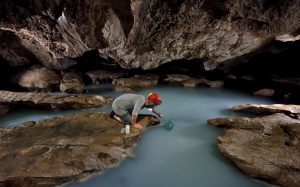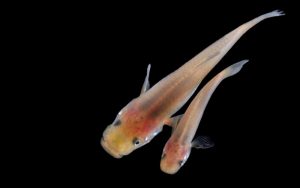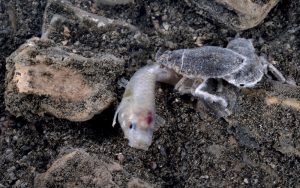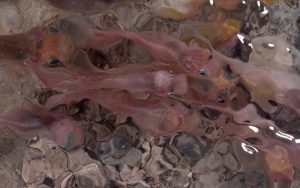 In the Cueva del Azufre system in Mexico, nature provides us with a unique natural experiment. The small livebearing fish, Poecilia mexicana, inhabits surface and cave habitats, some of which contain high concentrations of hydrogen sulfide (H2S). Current research projects focus on the general ecology of the unique cave ecosystem, as the evolutionary ecology of the different P. mexicana populations, and the genetic basis of the striking phenotypic variation observed across proximate – albeit environmentally distinct – populations.
In the Cueva del Azufre system in Mexico, nature provides us with a unique natural experiment. The small livebearing fish, Poecilia mexicana, inhabits surface and cave habitats, some of which contain high concentrations of hydrogen sulfide (H2S). Current research projects focus on the general ecology of the unique cave ecosystem, as the evolutionary ecology of the different P. mexicana populations, and the genetic basis of the striking phenotypic variation observed across proximate – albeit environmentally distinct – populations.
Effects of adverse environmental factors on phenotypic evolution
 In the Cueva del Azufre system, P. mexicana not only have to cope with perpetual darkness and acutely toxic levels of H2S, but biotic environmental conditions, such as food availability and predation regime, also differ among habitat types. We study causes and consequences of local adaptation of populations living under different environmental conditions.
In the Cueva del Azufre system, P. mexicana not only have to cope with perpetual darkness and acutely toxic levels of H2S, but biotic environmental conditions, such as food availability and predation regime, also differ among habitat types. We study causes and consequences of local adaptation of populations living under different environmental conditions.
Predator-prey-interactions
 Cave fish are usually considered the top predators in their ecosystems. In the Cueva del Azufre system, however, cave fish are preyed upon by giant water-bugs of the genus Belostoma, which occur at high densities. We investigate factors affecting Belostoma predation on cave fish (e.g., what are the underlying causes of sex- and size-specific predation?). Furthermore, we study the potential evolutionary consequences of differential predation by the water-bugs.
Cave fish are usually considered the top predators in their ecosystems. In the Cueva del Azufre system, however, cave fish are preyed upon by giant water-bugs of the genus Belostoma, which occur at high densities. We investigate factors affecting Belostoma predation on cave fish (e.g., what are the underlying causes of sex- and size-specific predation?). Furthermore, we study the potential evolutionary consequences of differential predation by the water-bugs.
Food web analyses
 Whereas the absence of light precludes photo-autotrophic primary production in caves, the presence of H2S allows for chemoautotropic production by sulfide-oxidizing bacteria in sulfidic habitats. We use stable isotope analyses to elucidate the food web structure as well as the sources of carbon in different habitat types.
Whereas the absence of light precludes photo-autotrophic primary production in caves, the presence of H2S allows for chemoautotropic production by sulfide-oxidizing bacteria in sulfidic habitats. We use stable isotope analyses to elucidate the food web structure as well as the sources of carbon in different habitat types.
